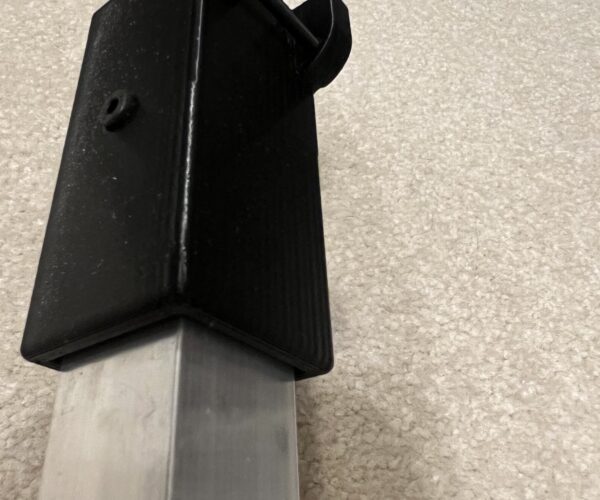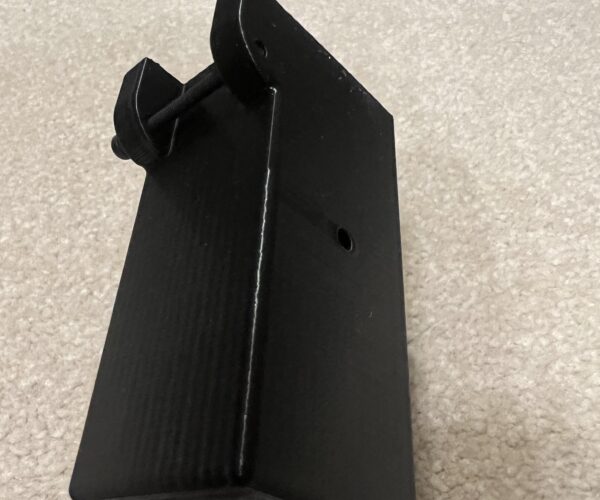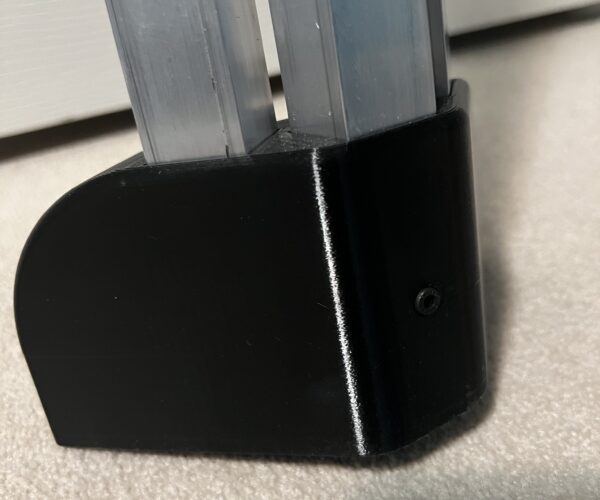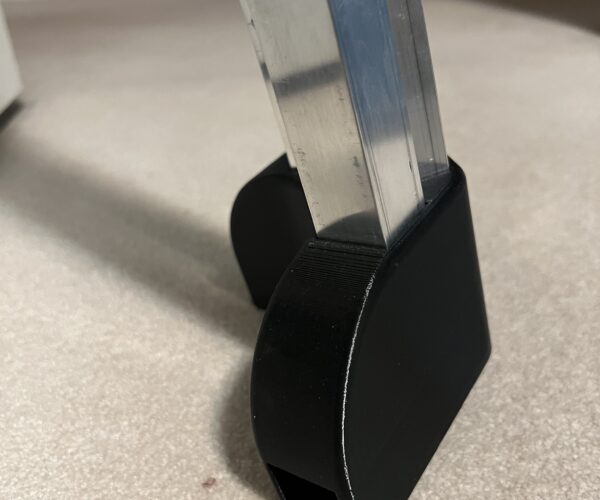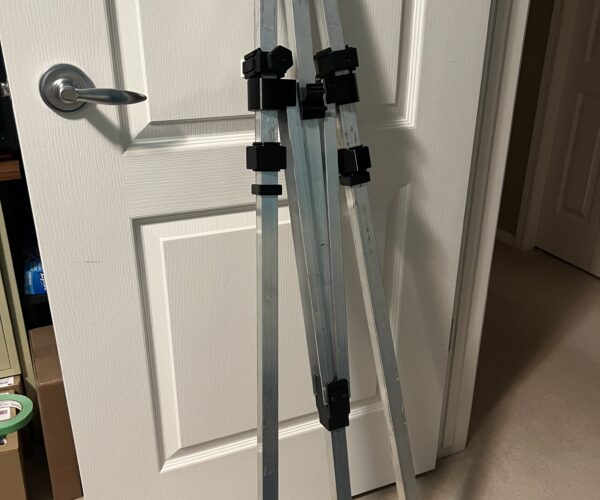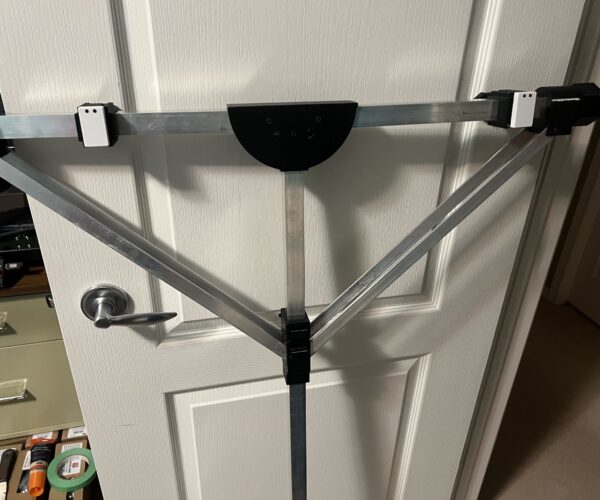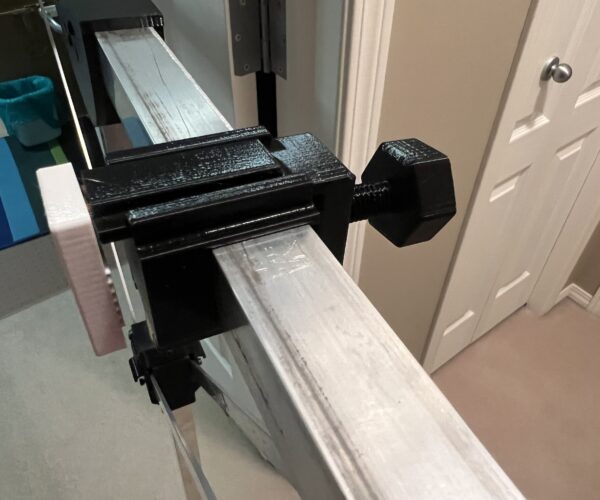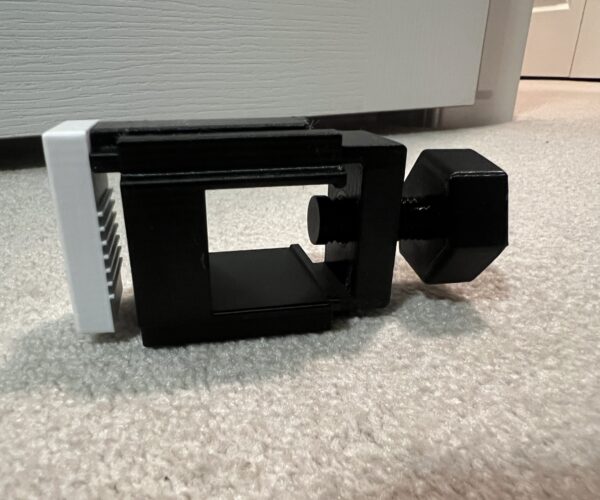Suggestions on Which Type of Filament to Use
I'm making vent hoods for my printers and my CNC system. I'm going to use square aluminum rods and use something like this to join the rods together: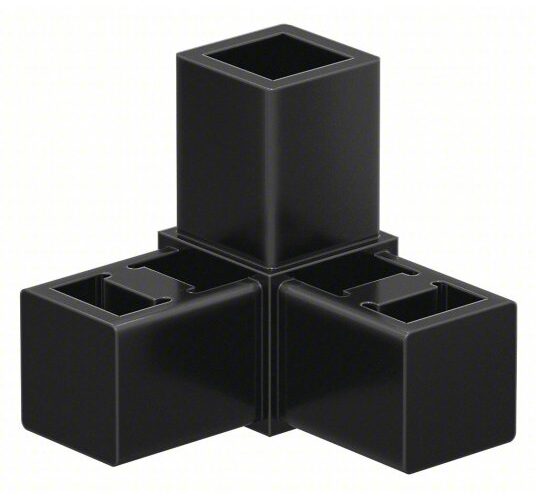
I need to do a bit of custom design work, so I can't use off-the-shelf parts. The vent hood for the printers may be supporting up to 10 filament spools (so, I figure, a bit more than 10 kg), and that weight will be distributed over several of the aluminum rods. I'm not sure what filaments would be a good choice for this. For my design, I'm thinking of including screw holes and maybe even reinforcing the area around a screw so I can use a self-taping screw with a hole a bit smaller than the screw threads. (There are benefits to not having a nut on the other side of the rod - only having a screw head on one side.)
I don't know if this matters, but once I get the aluminum frame done, I'll be putting magnetic strips on the aluminum and using magnets to hold some strong plastic sheeting in place to keep fumes (and smoke, when I use the laser on the CNC) in the hood until I turn the fan on to vent. (I probably will have doors in the print vent hood and those doors might use the aluminum frame and plexiglass for stability and rigidity.)
I've used PLA and PETG, but never ABS. I'm printing in my workshop, where I spend a lot of time and I'm in a seriously humid climate, so I don't want to open the doors or windows for ventilation. I've heard ABS doesn't just stink, but is not healthy to inhale. I'm thinking of going with PETG for this, but I could also bootstrap my way up. I could do the original pieces in PETG for the print hood and, once that's done and my ventilation system is working, then printing with ABS would be easier, since the fumes would be stuck in the hood until after it's done and had some cooling time and I can turn on the vent fan.
What would be a good filament (or good filaments) to use for something like this?
RE: Suggestions on Which Type of Filament to Use
Looks very similar to my project - a "quilt stand" which is basically a T-shaped device 2.5m tall and 2m wide, made from 1" sq. aluminum tubing with printed attachments and joints. I used PETG for my first attempt. I'm making it to fold down into a smaller size, and the hinge I made was too weak. But I think yours will be under less stress and PETG would be perfect.
I also went with the bolt tapping into the plastic solution to fix the tubing into the PETG fixtures. That part is working very well - all the stress is perpendicular to the bolt so it's totally sufficient. When I get it sufficiently robust I'll post it on printables.
Prusa MK4 since Jan 2024, Printables: @MikeB_1505898
RE: Suggestions on Which Type of Filament to Use
Looks very similar to my project - a "quilt stand" which is basically a T-shaped device 2.5m tall and 2m wide, made from 1" sq. aluminum tubing with printed attachments and joints. I used PETG for my first attempt. I'm making it to fold down into a smaller size, and the hinge I made was too weak. But I think yours will be under less stress and PETG would be perfect.
I would agree that, without hinges, I'd be dealing with less stress. (There will be hinges, but off-the-shelf metal ones fastening directly to the aluminum rods.)
I also went with the bolt tapping into the plastic solution to fix the tubing into the PETG fixtures. That part is working very well - all the stress is perpendicular to the bolt so it's totally sufficient. When I get it sufficiently robust I'll post it on printables.
Any chance you could include a few photos? I follow what you say, but I'd be interested in seeing at least the part with the screw holes. (I'm a visual learner - pics are a major help to me!)
RE: Suggestions on Which Type of Filament to Use
Projects like this (i did a couple) I normally start with simple PLA 🙂
And next stick to PLA 🙂
Let me explain (I learned this from watching https://www.youtube.com/@slant3d videos.
- When designing we mostly design from what we know, where we came from (somehow mechanical engineers think in steel, metals, joints; carpenters think in wood; shaving, nailing, etcetera). For 3d Printing we just have a short history, and look a lot (probably to much) to how it is done in plastic molding industry.
- But we have 3D Printing!. So if we want to know if a piece is strong enough? We just print a testpart and test it.
- If we notice it breaks or bends or whatever, we add perimeters, more/other infill, or bow/bridge constructions to make it stronger
- and test again.
Switching to other filaments is only needed if there are features your present filament does not have, like temperature, etcetera.
So looking at your picture: test some stuff, see if it hold 20 kg or more, try to break it, and you will have a good feel for the weak spots:
- you might make the parts a bit thicker, more perimeters, what already makes a huge difference without adding to much weight.
- you might add fillets where you think it will break.
- and last but not least, think about printing orientation. the horizontal layers are stronger then the vertical. so print it in a 45 degree angle.
PS: And if changing to other filament, think about PLA+.
Happy designing. Regards, Eef
We will do what we have always done. We will find hope in the impossible.
RE: Suggestions on Which Type of Filament to Use
I started printing with PETG and use it for 90% of my prints, so I'm more used to it than PLA :-). But working with what you know has merit.
Here's some photos:
Prusa MK4 since Jan 2024, Printables: @MikeB_1505898
RE: Suggestions on Which Type of Filament to Use
I started printing with PETG and use it for 90% of my prints, so I'm more used to it than PLA :-). But working with what you know has merit.
I've found I like what I do in PETG better than some of what I do with PLA, but PLA is also faster to print with, so when I can use PLA, I'll often go with that. Also, on my first PETG print, I had a terrible time getting it off the smooth metal PEI sheet (a Prusa sheet) and it even pulled up some of the coating over the sheet! I asked about it and the tip I've been using is to heat up my print bed before removing a PETG print. The person suggested heating it up to 60°C, but I found 80°C works better. (Yeah - hot for handling!) And once it heats up to that, I pull the bed off and flex it, which gets the process going, but then I use a flat blade, a bit like a putty knife (but not as inflexible) and slide it in between the bed and the object. That takes time, but gets the print off - but not always without causing bed damage. (I also found that trying to remove PETG while the bed is still warm wasn't always easy - I found letting it cool, then reheating to 80°C worked best.)
I remember one person said they found a textured sheet worked better, so I have one on order.
If you have suggestions to speed up PETG prints or to make it easier to get PETG off the print bed, I would love to hear them! There are situations where I could deal with the longer print time if I could just be sure I could remove PETG objects from the sheet on the bed more easily.
Thanks for the photos - cool work you did there! It looks to me like you used the self-tapping screw to grip to the aluminum. In my situation, since I want smooth surfaces so I can put magnetic tape on them to be used with magnets to hold the plastic in place, I'm making connectors that go *inside* the square rods and the self tapping-screws will grip on the printed connector.
When designing we mostly design from what we know, where we came from (somehow mechanical engineers think in steel, metals, joints; carpenters think in wood; shaving, nailing, etcetera).
That's an excellent point and one I've been very well aware of! I realized that about 7-9 years ago, during the process of buying our lot, doing a lot of survey work (on my own) and having our house built. My friend, who is a contractor was the GC (General Contractor). He handled the actual house and I handled retaining walls, the 1/2 mile driveway, and everything else - including bridging the creek, which, by wetland regs, had to be about 6' above the creek bed so the surface was 1" above the 100 year floodplain. My Dad had a large garage stuff with tools when I was growing up and I learned how to do a lot with wood and metal, but always loved wood.
It was during the design process I realized that I always defaulted to wood for anything I handled and I had to change that habit and attitude in a hurry because concrete (which I had never used), or large amounts of rip rap or other forms of gravel were the answer.
You make an excellent point and often there's more than one way to do it. (Learned that lesson from a programming language - where I learned the same lesson - we want to use the languages we know best for everything and sometimes that's the case, sometimes one language just won't do what another does well.) So I default to wood whenever I can. (I also just like wood - I like the feel and sense of it more than metal or concrete or plastic.)
Actually, for this project, I did look at wood first, but quickly realized that since the vent hood over the CNC needs to be hinged and easy to lift, that I need a metal frame, so I had to reject wood for it. (Still likely that I'll use wood for the table legs and frame, though, but that could change.)
But we have 3D Printing!. So if we want to know if a piece is strong enough? We just print a testpart and test it.
- If we notice it breaks or bends or whatever, we add perimeters, more/other infill, or bow/bridge constructions to make it stronger
- and test again.
True, but I'm also not familiar with how PETG and PLA (and ABS) compare at this point because I've only used PETG for a few items and haven't yet used ABS. In one case, with parts I have printed, I asked about what to use and the answer was PETG because PLA will break down in the sunlight after a while and PETG won't. You make the point (didn't quote that line - oh, well!) that sometimes you do have to pick a material for specific needs. Agreed. But, also, sometimes you can save a lot of time with test prints if you find out another material does things a preferred filament doesn't.
So looking at your picture: test some stuff, see if it hold 20 kg or more, try to break it, and you will have a good feel for the weak spots
One reason I was asking was with that thought in mind. While these parts are not meant to hold a lot of weight (although the 10 kg I figure in the case of using 2 printers, each with an MMU, allowing up to 5 filaments, at 1 kg per spool, is not lightweight, it's not that heavy), I know PLA can break more easily than PETG and that ABS is supposed to be rather strong, so, in this case, I'm asking for feedback to get an idea of if PETG or ABS is going to make a big difference.
Also, and I think I touched on this, if one material has an advantage I don't know about, that can save a lot of time in test prints and adjustments.
- you might make the parts a bit thicker, more perimeters, what already makes a huge difference without adding to much weight.
- you might add fillets where you think it will break.
- and last but not least, think about printing orientation. the horizontal layers are stronger then the vertical. so print it in a 45 degree angle.
Some of this is part of my normal design process. One issue here is that the connectors I'm making go inside the square aluminum rods, so there are some measurements I can't change.
Print orientation - that's always an interesting (and sometimes maddening!) issue. Sometimes a part can only be printed in one orientation. I have a few connectors that will have that issue.
Thanks for all the tips!
RE: Suggestions on Which Type of Filament to Use
I started printing with PETG and use it for 90% of my prints, so I'm more used to it than PLA :-). But working with what you know has merit.
I've found I like what I do in PETG better than some of what I do with PLA, but PLA is also faster to print with, so when I can use PLA, I'll often go with that. Also, on my first PETG print, I had a terrible time getting it off the smooth metal PEI sheet (a Prusa sheet) and it even pulled up some of the coating over the sheet! I asked about it and the tip I've been using is to heat up my print bed before removing a PETG print. The person suggested heating it up to 60°C, but I found 80°C works better. (Yeah - hot for handling!) And once it heats up to that, I pull the bed off and flex it, which gets the process going, but then I use a flat blade, a bit like a putty knife (but not as inflexible) and slide it in between the bed and the object. That takes time, but gets the print off - but not always without causing bed damage. (I also found that trying to remove PETG while the bed is still warm wasn't always easy - I found letting it cool, then reheating to 80°C worked best.)
I remember one person said they found a textured sheet worked better, so I have one on order.
If you have suggestions to speed up PETG prints or to make it easier to get PETG off the print bed, I would love to hear them! There are situations where I could deal with the longer print time if I could just be sure I could remove PETG objects from the sheet on the bed more easily.
Thanks for the photos - cool work you did there! It looks to me like you used the self-tapping screw to grip to the aluminum. In my situation, since I want smooth surfaces so I can put magnetic tape on them to be used with magnets to hold the plastic in place, I'm making connectors that go *inside* the square rods and the self tapping-screws will grip on the printed connector.
I haven't really noticed PLA being faster to print than PETG but then I haven't compared identical prints. I guess I could just generate gcode from both materials for the same print and see how they compare.
I did the same thing the first time I printed with PETG - tore off some of the PEI on the smooth sheet! I ordered the textured and satin sheets. I really like the texture for the textured sheet. But, I soon discovered that the satin sheet works beautifully for both PETG and PLA and I've been defaulting to that sheet ever since. Once it cools down, both materials just slide off most of the time.
Actually, I don't use self-tapping screws - just the regular socket cap metric bolt. With the right diameter of hole in the plastic the threads grip very well. The holes in the aluminum allow the bolt to slide through. Right now I only have about 1 mm of thread engaged because the bolts are too short, but it's working anyway since nothing is really pulling hard in any direction.
Prusa MK4 since Jan 2024, Printables: @MikeB_1505898
RE: Suggestions on Which Type of Filament to Use
I haven't really noticed PLA being faster to print than PETG but then I haven't compared identical prints. I guess I could just generate gcode from both materials for the same print and see how they compare.
I just compared them in PrusaSlicer. It started by accident. I was printing out all the wall plates and parts of my ventilation system and had been scheduling my prints so I would start the longest ones for before going to bed. I wasn't memorizing print times, but was noticing them as I compared parts. Then, after finishing one print, I had forgotten to change the filament type in the slicer and loaded an STL and thought, "Waitaminnit! That one took under 3 hours. Why is it taking 4?" That's when I realized I had not changed the filament and that the time difference was due to that.
I did the same thing the first time I printed with PETG - tore off some of the PEI on the smooth sheet! I ordered the textured and satin sheets. I really like the texture for the textured sheet. But, I soon discovered that the satin sheet works beautifully for both PETG and PLA and I've been defaulting to that sheet ever since. Once it cools down, both materials just slide off most of the time.
Is the satin sheet a Prusa one? I don't remember seeing it as an option. (Wish I knew about it a few days ago, before I placed my latest order!) While I don't have a problem with 3rd party parts, I started with a Creality Ender 3 Pro, and it was a nightmare - it took 5 months to get it working and I can put the issue directly on Creality. (Long story - but I can back up what I'm saying about them.) So I got fed up and ordered my Prusa and found "it just works." It's like dealing with my Macs - they just work. I can muck about with them (I'm a hacker from way back even in the 70s), but often I find it's better just leaving them as they are. With my Prusa system, everything works fine and often I don't have the time to, for example, order other metal sheets and do a number of test prints to see how well they work. With the shipping fees, the cost is higher, but often I save a good amount of time by just ordering from Prusa. I know whatever I get will work and I won't spend hours trying to figure it out.
Actually, I don't use self-tapping screws - just the regular socket cap metric bolt. With the right diameter of hole in the plastic the threads grip very well. The holes in the aluminum allow the bolt to slide through. Right now I only have about 1 mm of thread engaged because the bolts are too short, but it's working anyway since nothing is really pulling hard in any direction.
Okay, I misunderstood about the screws.
In my case, since I want plastic to fit tightly against the metal frame, I decided to use magnetic strips of tape on the aluminum rods (and it'll go along on the printed connectors, too). Then I can put plastic, something like 2mil or 4 mil, against the frame and hold it into place with magnet strips. Since I want to keep fumes from escaping (on the hood for the printers) and smoke from escaping (on the CNC hood), I want the surfaces the plastic is held against to be smooth, so my connectors have to slide into the square rods and, where the plastic comes out of the rod, it'll have to match the rod size so it's just one long smooth surface, from the edge of the connector on one end to the edge of the connector on the other end.
